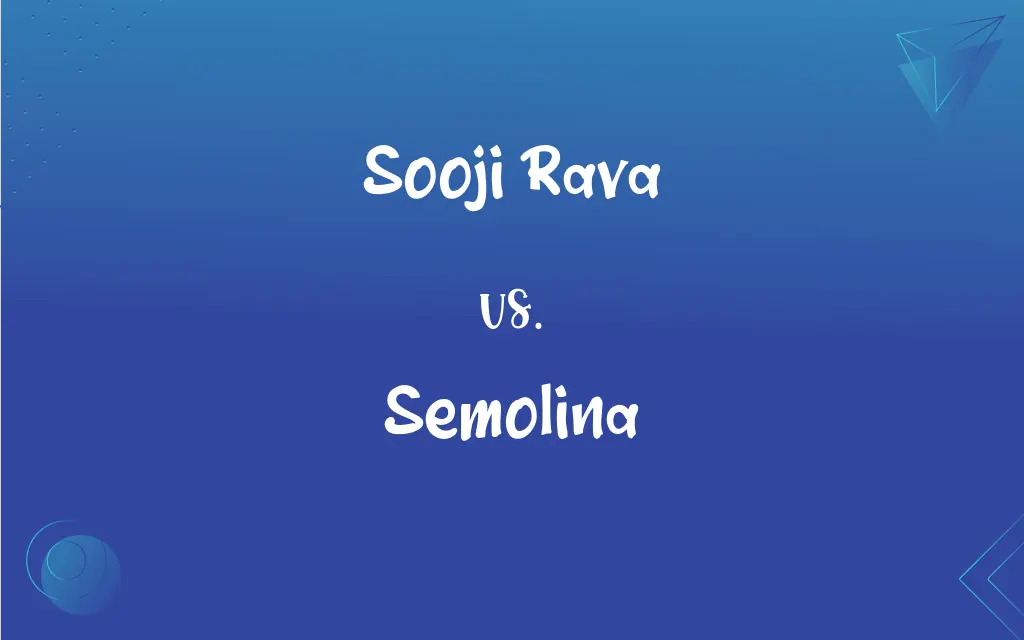Sooji Rava vs. Semolina: What's the Difference?
Edited by Aimie Carlson || By Janet White || Updated on July 26, 2024
Sooji rava and semolina refer to the same ground wheat product, but "sooji rava" is commonly used in Indian cuisine, while "semolina" is the term used in Western and Mediterranean contexts.

Key Differences
Sooji rava and semolina are terms that often cause confusion due to their interchangeable use in different culinary traditions. Sooji rava, widely recognized in Indian cuisine, refers to a coarse, granulated flour made from durum wheat. Semolina, on the other hand, is the term more commonly used in Western and Mediterranean cuisines. It is essentially the same product as sooji rava, made from ground durum wheat, and serves as the foundation for many traditional dishes in these regions.
Both sooji rava and semolina share the same origin, being derived from durum wheat, which is known for its high protein and gluten content. This makes both excellent choices for creating dishes that are hearty and satisfying. Despite their similarities, the primary difference lies in their contextual use and the specific dishes they are associated with in various culinary traditions.
In Indian cuisine, sooji rava's role is indispensable. It is used in both main courses and desserts, showcasing its adaptability in texture and flavor. The preparation methods and the spices used with sooji rava are tailored to fit the aromatic and vibrant profile of Indian dishes. Semolina’s use in Western and Mediterranean cuisines leans more towards bakery and pasta products, highlighting its ability to enhance the texture and structural integrity of these items.
Understanding the distinction between sooji rava and semolina is essential for culinary enthusiasts exploring diverse recipes. While they are the same product, the name used often indicates the culinary tradition and the types of dishes it is most commonly associated with. This understanding enriches one’s cooking repertoire and allows for more authentic culinary experiences.
Comparison Chart
Culinary Tradition
Predominantly used in Indian cuisine
Commonly used in Western and Mediterranean cuisines
ADVERTISEMENT
Common Dishes
Upma, halwa, dosa
Pasta, bread, basbousa
Texture
Coarse and granular, ideal for absorbing flavors
Fine and granular, suitable for doughs requiring elasticity
Primary Use
Versatile in both savory and sweet dishes
Often used in bakery products and pasta
Cultural Significance
Essential in traditional Indian cooking and festivals
Key ingredient in many traditional Western and Mediterranean dishes
Sooji Rava and Semolina Definitions
Sooji Rava
Granular in texture, ideal for absorbing flavors.
Sooji rava absorbs the spices well, making the dish flavorful.
ADVERTISEMENT
Semolina
Essential for traditional Mediterranean sweets.
Basbousa, a sweet cake, requires fine semolina for its texture.
Sooji Rava
A coarse flour made from durum wheat.
Sooji rava is essential for making authentic Indian upma.
Semolina
A versatile ingredient in Western cooking.
Semolina is used in both savory dishes and desserts in Western cuisine.
Sooji Rava
A staple ingredient in traditional Indian cooking.
Indian kitchens always have sooji rava stocked for various recipes.
Semolina
Widely used in making pasta and bakery products.
The baker uses semolina for its unique texture in bread.
Sooji Rava
Used in Indian cuisine for both savory and sweet dishes.
For the festival, she made a sweet halwa with sooji rava.
Semolina
Ground durum wheat, fine and granular.
Semolina is the key to making perfect, al dente pasta.
Sooji Rava
Integral to breakfast dishes in India.
Breakfast often includes dosa made from sooji rava for a crisp texture.
Semolina
Known for its high protein and gluten content.
Semolina's high gluten content makes it perfect for elastic doughs.
Semolina
The coarser particles produced by milling durum wheat, used especially for making pastas and hot cereals.
Semolina
Coarse grains produced at an intermediate stage of wheat flour milling.
Semolina
Such grains, usually from durum wheat, used in the preparation of pasta, couscous and various sweet dishes.
Semolina
(culinary) semolina pudding
Semolina
The purified fine, hard parts of durum wheat, derived mostly from the endosperm, rounded by the attrition of the millstones, - used in cookery, such as in the preparation of Italian pasta.
Semolina
Milled product of durum wheat (or other hard wheat) used in pasta
FAQs
What makes sooji rava ideal for Indian cuisine?
Its ability to absorb flavors and its versatility in both savory and sweet dishes make it ideal for Indian cuisine.
What is sooji rava?
Sooji rava is a coarse, granulated flour made from durum wheat, used extensively in Indian cuisine.
Can I use sooji rava for making pasta?
Yes, sooji rava can be used for making pasta due to its similar texture and composition as semolina.
Is semolina good for making sweets?
Yes, semolina works well in sweets, providing a fine texture and subtle flavor.
Are sooji rava and semolina interchangeable?
Yes, they can be used interchangeably, but the dish's authenticity might vary based on the cuisine.
Is semolina suitable for making Indian sweets?
Absolutely, semolina can be used in Indian sweets like halwa, providing a similar texture and taste to sooji rava.
What are some popular semolina-based dishes?
Pasta, bread, and Mediterranean sweets like basbousa are popular semolina-based dishes.
What is semolina?
Semolina is a term for a similar product as sooji rava, but it is more commonly used in Western and Mediterranean cooking.
What is the nutritional value of sooji rava?
Sooji rava is high in carbohydrates and protein, with essential vitamins and minerals.
How does the texture of sooji rava benefit Indian dishes?
Its granular texture is perfect for absorbing flavors, enhancing the taste of Indian dishes.
Why is semolina preferred in bakery products?
Its fine texture and high gluten content make semolina perfect for bakery products, offering elasticity and structure.
How should sooji rava be stored?
Store sooji rava in an airtight container in a cool, dry place to maintain its freshness.
Can sooji rava be used for making bread?
Yes, sooji rava can be used for making bread, offering a unique texture and flavor.
Are there any dietary considerations with sooji rava?
Those with gluten intolerance or celiac disease should avoid sooji rava due to its wheat content.
Can sooji rava and semolina be used in gluten-free recipes?
No, both are made from durum wheat, which contains gluten.
What dishes are commonly made with sooji rava?
Dishes like upma, dosa, and halwa are commonly made with sooji rava in Indian cuisine.
Does semolina have any health benefits?
Yes, semolina is rich in protein, vitamins, and minerals, making it a nutritious addition to diets.
Can I substitute semolina for sooji rava in recipes?
Yes, they can be substituted for each other, keeping in mind the slight differences in texture.
What makes semolina a versatile ingredient?
Its fine texture and nutritional profile make semolina versatile in both savory and sweet recipes across various cuisines.
Why is semolina preferred for pasta making?
Its high gluten content gives pasta dough elasticity and firmness, ideal for various pasta shapes.
About Author
Written by
Janet WhiteJanet White has been an esteemed writer and blogger for Difference Wiki. Holding a Master's degree in Science and Medical Journalism from the prestigious Boston University, she has consistently demonstrated her expertise and passion for her field. When she's not immersed in her work, Janet relishes her time exercising, delving into a good book, and cherishing moments with friends and family.
Edited by
Aimie CarlsonAimie Carlson, holding a master's degree in English literature, is a fervent English language enthusiast. She lends her writing talents to Difference Wiki, a prominent website that specializes in comparisons, offering readers insightful analyses that both captivate and inform.






































































